Ahmed Ali
CS-FLEURS: A Massively Multilingual and Code-Switched Speech Dataset
Sep 17, 2025Abstract:We present CS-FLEURS, a new dataset for developing and evaluating code-switched speech recognition and translation systems beyond high-resourced languages. CS-FLEURS consists of 4 test sets which cover in total 113 unique code-switched language pairs across 52 languages: 1) a 14 X-English language pair set with real voices reading synthetically generated code-switched sentences, 2) a 16 X-English language pair set with generative text-to-speech 3) a 60 {Arabic, Mandarin, Hindi, Spanish}-X language pair set with the generative text-to-speech, and 4) a 45 X-English lower-resourced language pair test set with concatenative text-to-speech. Besides the four test sets, CS-FLEURS also provides a training set with 128 hours of generative text-to-speech data across 16 X-English language pairs. Our hope is that CS-FLEURS helps to broaden the scope of future code-switched speech research. Dataset link: https://huggingface.co/datasets/byan/cs-fleurs.
Towards a Unified Benchmark for Arabic Pronunciation Assessment: Quranic Recitation as Case Study
Jun 09, 2025Abstract:We present a unified benchmark for mispronunciation detection in Modern Standard Arabic (MSA) using Qur'anic recitation as a case study. Our approach lays the groundwork for advancing Arabic pronunciation assessment by providing a comprehensive pipeline that spans data processing, the development of a specialized phoneme set tailored to the nuances of MSA pronunciation, and the creation of the first publicly available test set for this task, which we term as the Qur'anic Mispronunciation Benchmark (QuranMB.v1). Furthermore, we evaluate several baseline models to provide initial performance insights, thereby highlighting both the promise and the challenges inherent in assessing MSA pronunciation. By establishing this standardized framework, we aim to foster further research and development in pronunciation assessment in Arabic language technology and related applications.
Beyond Orthography: Automatic Recovery of Short Vowels and Dialectal Sounds in Arabic
Aug 05, 2024

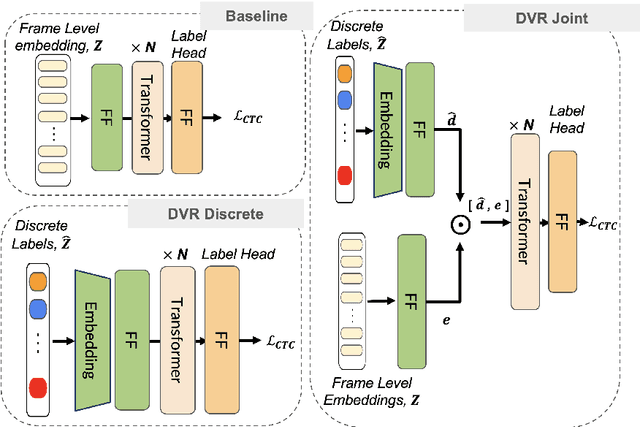

Abstract:This paper presents a novel Dialectal Sound and Vowelization Recovery framework, designed to recognize borrowed and dialectal sounds within phonologically diverse and dialect-rich languages, that extends beyond its standard orthographic sound sets. The proposed framework utilized a quantized sequence of input with(out) continuous pretrained self-supervised representation. We show the efficacy of the pipeline using limited data for Arabic, a dialect-rich language containing more than 22 major dialects. Phonetically correct transcribed speech resources for dialectal Arabic are scarce. Therefore, we introduce ArabVoice15, a first-of-its-kind, curated test set featuring 5 hours of dialectal speech across 15 Arab countries, with phonetically accurate transcriptions, including borrowed and dialect-specific sounds. We described in detail the annotation guideline along with the analysis of the dialectal confusion pairs. Our extensive evaluation includes both subjective -- human perception tests and objective measures. Our empirical results, reported with three test sets, show that with only one and half hours of training data, our model improve character error rate by ~ 7\% in ArabVoice15 compared to the baseline.
Speech Representation Analysis based on Inter- and Intra-Model Similarities
Jun 23, 2024Abstract:Self-supervised models have revolutionized speech processing, achieving new levels of performance in a wide variety of tasks with limited resources. However, the inner workings of these models are still opaque. In this paper, we aim to analyze the encoded contextual representation of these foundation models based on their inter- and intra-model similarity, independent of any external annotation and task-specific constraint. We examine different SSL models varying their training paradigm -- Contrastive (Wav2Vec2.0) and Predictive models (HuBERT); and model sizes (base and large). We explore these models on different levels of localization/distributivity of information including (i) individual neurons; (ii) layer representation; (iii) attention weights and (iv) compare the representations with their finetuned counterparts.Our results highlight that these models converge to similar representation subspaces but not to similar neuron-localized concepts\footnote{A concept represents a coherent fragment of knowledge, such as ``a class containing certain objects as elements, where the objects have certain properties. We made the code publicly available for facilitating further research, we publicly released our code.
Automatic Pronunciation Assessment -- A Review
Oct 21, 2023Abstract:Pronunciation assessment and its application in computer-aided pronunciation training (CAPT) have seen impressive progress in recent years. With the rapid growth in language processing and deep learning over the past few years, there is a need for an updated review. In this paper, we review methods employed in pronunciation assessment for both phonemic and prosodic. We categorize the main challenges observed in prominent research trends, and highlight existing limitations, and available resources. This is followed by a discussion of the remaining challenges and possible directions for future work.
Speech collage: code-switched audio generation by collaging monolingual corpora
Sep 27, 2023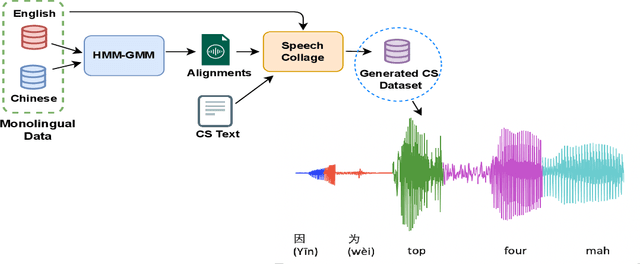

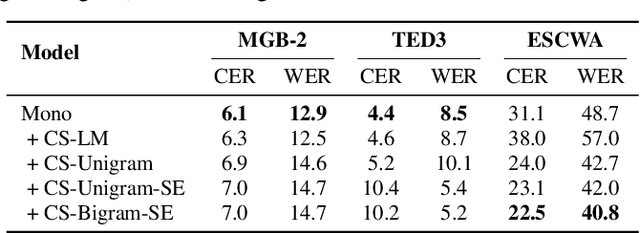
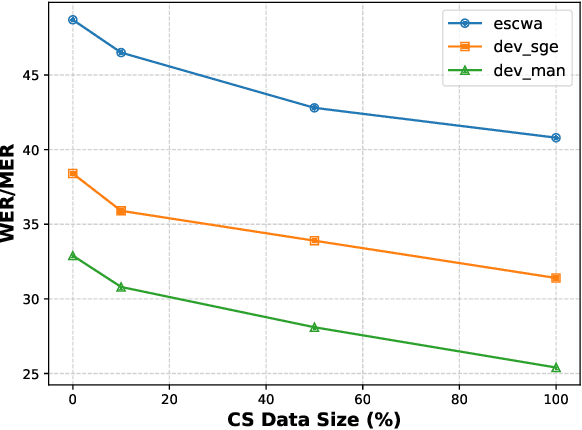
Abstract:Designing effective automatic speech recognition (ASR) systems for Code-Switching (CS) often depends on the availability of the transcribed CS resources. To address data scarcity, this paper introduces Speech Collage, a method that synthesizes CS data from monolingual corpora by splicing audio segments. We further improve the smoothness quality of audio generation using an overlap-add approach. We investigate the impact of generated data on speech recognition in two scenarios: using in-domain CS text and a zero-shot approach with synthesized CS text. Empirical results highlight up to 34.4% and 16.2% relative reductions in Mixed-Error Rate and Word-Error Rate for in-domain and zero-shot scenarios, respectively. Lastly, we demonstrate that CS augmentation bolsters the model's code-switching inclination and reduces its monolingual bias.
L1-aware Multilingual Mispronunciation Detection Framework
Sep 21, 2023Abstract:The phonological discrepancies between a speaker's native (L1) and the non-native language (L2) serves as a major factor for mispronunciation. This paper introduces a novel multilingual MDD architecture, L1-MultiMDD, enriched with L1-aware speech representation. An end-to-end speech encoder is trained on the input signal and its corresponding reference phoneme sequence. First, an attention mechanism is deployed to align the input audio with the reference phoneme sequence. Afterwards, the L1-L2-speech embedding are extracted from an auxiliary model, pretrained in a multi-task setup identifying L1 and L2 language, and are infused with the primary network. Finally, the L1-MultiMDD is then optimized for a unified multilingual phoneme recognition task using connectionist temporal classification (CTC) loss for the target languages: English, Arabic, and Mandarin. Our experiments demonstrate the effectiveness of the proposed L1-MultiMDD framework on both seen -- L2-ARTIC, LATIC, and AraVoiceL2v2; and unseen -- EpaDB and Speechocean762 datasets. The consistent gains in PER, and false rejection rate (FRR) across all target languages confirm our approach's robustness, efficacy, and generalizability.
The complementary roles of non-verbal cues for Robust Pronunciation Assessment
Sep 14, 2023Abstract:Research on pronunciation assessment systems focuses on utilizing phonetic and phonological aspects of non-native (L2) speech, often neglecting the rich layer of information hidden within the non-verbal cues. In this study, we proposed a novel pronunciation assessment framework, IntraVerbalPA. % The framework innovatively incorporates both fine-grained frame- and abstract utterance-level non-verbal cues, alongside the conventional speech and phoneme representations. Additionally, we introduce ''Goodness of phonemic-duration'' metric to effectively model duration distribution within the framework. Our results validate the effectiveness of the proposed IntraVerbalPA framework and its individual components, yielding performance that either matches or outperforms existing research works.
LLMeBench: A Flexible Framework for Accelerating LLMs Benchmarking
Aug 09, 2023


Abstract:The recent development and success of Large Language Models (LLMs) necessitate an evaluation of their performance across diverse NLP tasks in different languages. Although several frameworks have been developed and made publicly available, their customization capabilities for specific tasks and datasets are often complex for different users. In this study, we introduce the LLMeBench framework. Initially developed to evaluate Arabic NLP tasks using OpenAI's GPT and BLOOM models; it can be seamlessly customized for any NLP task and model, regardless of language. The framework also features zero- and few-shot learning settings. A new custom dataset can be added in less than 10 minutes, and users can use their own model API keys to evaluate the task at hand. The developed framework has been already tested on 31 unique NLP tasks using 53 publicly available datasets within 90 experimental setups, involving approximately 296K data points. We plan to open-source the framework for the community (https://github.com/qcri/LLMeBench/). A video demonstrating the framework is available online (https://youtu.be/FkQn4UjYA0s).
MyVoice: Arabic Speech Resource Collaboration Platform
Jul 23, 2023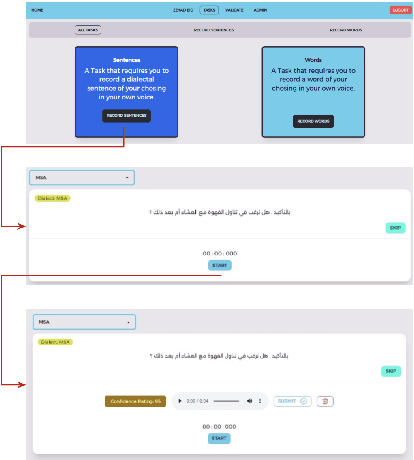
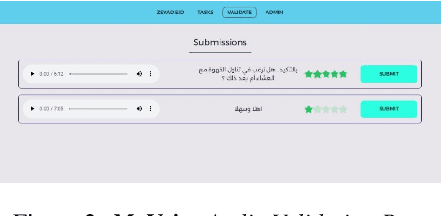
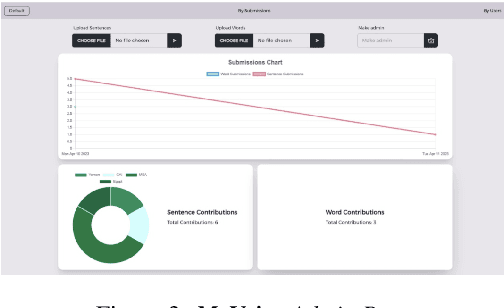
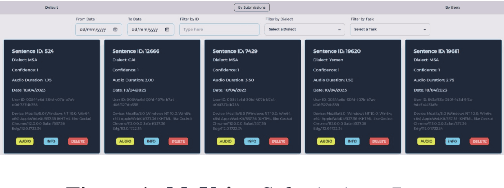
Abstract:We introduce MyVoice, a crowdsourcing platform designed to collect Arabic speech to enhance dialectal speech technologies. This platform offers an opportunity to design large dialectal speech datasets; and makes them publicly available. MyVoice allows contributors to select city/country-level fine-grained dialect and record the displayed utterances. Users can switch roles between contributors and annotators. The platform incorporates a quality assurance system that filters out low-quality and spurious recordings before sending them for validation. During the validation phase, contributors can assess the quality of recordings, annotate them, and provide feedback which is then reviewed by administrators. Furthermore, the platform offers flexibility to admin roles to add new data or tasks beyond dialectal speech and word collection, which are displayed to contributors. Thus, enabling collaborative efforts in gathering diverse and large Arabic speech data.
 Add to Chrome
Add to Chrome Add to Firefox
Add to Firefox Add to Edge
Add to Edge